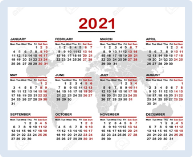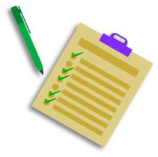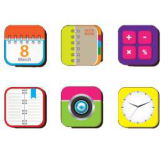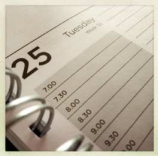Lesson : Top ten effective time-management tips for teachers
2. Read and translate the text. Match the headings A-I to paragraphs 1-8. There are two headings, you will not need to use.
Top eight effective time-management tips for teachers
Working as a teacher requires excellent time management skills. Teachers need to balance long-term goals of the classroom, the immediate educational needs of the students and the large volume of paperwork that comes with every assignment. Between writing lesson plans, grading exams and actually teaching, teachers often feel that it is impossible to fit everything into the allotted time frame.
Here are eight effective time-management tips that could help teachers manage their time, increase their productivity and provide a better education for their students.
1 __________. Consider the things that you have to do and the things you want to achieve. Think short-term as well as long-term. And using the SMART model, set yourself some clear objectives.
Your aims should be:
Specific
Measurable
Achievable
Realistic
Time-bound
2 __________. With clear goals, you can now go about planning how you spend your time and organising your days. Download a monthly planner or use a planner app to help you get a better overview of the steps you need to take to achieve those goals. Plan your day either the night before or the first thing that morning. Know what is important and what isn’t. Have a to-do list and enjoy the satisfaction of ticking each item off the list.
3 __________. Don’t feel like you need to take on everything that is given to you. Define your priorities and how a task might or might not contribute towards your goals. How would this new task or activity fit into your plans? If you are unsure, ask for time to decide by saying, “Can I think about it and get back to you on that?” It’s good to be helpful, but not to the detriment of your own health and sanity.
4 __________. A lot of teachers complain about the amount of time they spend planning their lessons. Would an impressive PowerPoint actually result in more learning than if that lesson were to be delivered on the whiteboard? There are plenty of lesson materials freely available online for the busy teacher to print out and use, so keep an eye on relevant Facebook groups and other various Internet resources that regularly post links to downloadable teaching materials. Bookmark useful websites and keep an organised folder of printouts/handouts that you’ve used so that you can re-use them again in the future.
5 __________. The other time-consuming activity that teachers complain about is the marking of homework and assignments. Unfortunately, there isn’t much enjoyable about marking, and the best thing to do is to be smart about it. If the marking is objective (e.g. there is a right or wrong answer), ask your students to do the marking. You can have them exchange papers with each other to ensure fairness. The added benefit is that our students will probably learn more from marking their own papers as it forces them to consider possible mistakes and the reasons behind the right answers. Plan to mark a small load at a time, rather than leaving them all till the last minute. Having the psychological burden of knowing you have a large pile of marking to do is not only soul-destroying but will more than likely make you procrastinate further. There are plenty of tech tools out there that can lighten your burden. Look into using Google Forms and their add-ons to help with homework and marking. Look into Jing to audio-record your feedback to their assignments, instead of having to write everything out.
6 __________. What do you waste time on each day? Is it browsing on AliExpress or ROZETKA™ for things you don’t need? Is it checking Facebook updates, looking at Instagram photos, or watching cute YouTube videos of cats? Do you find yourself splitting your attention between trying to watch something on television and playing a game on your phone, and then feeling deeply unsettled by the stress levels caused by dissatisfying multi-tasking? It’s important to (a) know what it is you’re wasting your time on each time. Remember that if you’re truly getting rest and relaxation from doing that activity, then it isn’t a time-waster and can be categorized as having ‘‘me-time’’. However, if the activity isn’t really relaxing you, then it’s time to cut it out of your day. Then, (b) proceed to set certain rules that will help you eliminate these distractions. For instance, decide that you will remain off-line when you are marking. Or have a no-multi-tasking rule when you’re meant to be relaxing.
7 __________. Apply the following little strategy to everything you do, i.e. if it takes less than two minutes to complete, then get it done now. It would take more than two minutes if you were to come back to do it later. You could apply this rule to answering questions in emails and online groups (e.g. WhatsApp, Viber, Google groups), dealing with admin requests, photocopying/printing out handouts, and even daily household chores (e.g. taking the bin out, washing up). You can also apply a variation of the “two-minute rule” to tasks that take a lot more than two minutes (e.g. estimating a pile of students’ papers, writing lesson-plans, etc.).
8 __________. All work and no play makes Jack a dull boy. Allow yourself time to relax, time to exercise and time to sleep. Keep a check on your work-life balance and engage in activities that nourish your body, your mind and your soul. Prioritizing time for personal needs is necessary to effectively implement and execute the plans for educating students. When teachers are exhausted due to lack of personal care and time, it is possible that the classroom becomes less effective and efficient. Implementing time-saving plans only works when a teacher is energetic, healthy and refreshed. Moreover, remember that a happy teacher will inspire happy students.
And if after reading these tips, you are still overcome by panic as you think about the mountain of work ahead of you, remember the proverb, “How do you eat an elephant? One bite at a time”.
2. After-reading activities.
What paragraphs (from 1-8) are about?
а) set aside personal time;
b) avoid “loaded” procrastination;
c) organize the day by priorities.
3. Key vocabulary.
3.1. Match the words on the left to the definitions on the right.
|
1. A goal |
a. A plan to meet someone at a particular time and place |
|
2. A deadline |
b. A time or day that you need to do something by |
|
3. A priority |
c. Needing to be done immediately |
|
4. A task |
d. Not done before now |
|
5. An appointment |
e. Something that is important and must be done first |
|
6. Overdue |
f. Something that you want to achieve |
|
7. Urgent |
g. Something you have to do that can be difficult
|
3.2. Read the words, listen to them and find their definitions here:
Schedule the Two-Minute Rule
Assignment time-bound
Priority detriment
Handout burden
Procrastinate waste
Eliminate distraction
nourish
3.3. Now, complete the sentences below using the words from the activity.
1. This bill is __________. Why wasnʼt it paid last month?
2. Remember that the __________ for the work is 5pm today.
3. This order is __________. The customer needs it tomorrow.
4. I can't go home yet. I still have one more __________ to finish.
5. Charlie set himself a __________ to finish the presentation by the end of the day.
6. Richard had an __________ to meet a new customer at 10am.
7. This email is a __________. You need to reply to it first.
3.4. Arrange the words into three group:
1) commitments outside study;
2) study goals;
3) work best.
Іn the morning, work, in a library, this week, family events, lots of coffee, at night, travel, childcare, today, at night, with music, lots of chocolate, next hour, in silence, at home.
4. Things to help with time management. Match the words to the pictures.
A calendar, a diary, apps, a schedule, a to-do list, colour coding.
|
1. _____________________ |
2. _____________________ |
3. _____________________ |



|
4. _____________________ |
5. _____________________ |
6. _______________________ |
5. Managing tasks.
Nina is the teacher of a primary school. It's Friday, 1 pm. The lessons are over. In pairs, look at her list of tasks below, and then decide if they are high priority (HP) or low priority (LP).
|
1 |
arrange a parent-teacher meeting next Friday |
|
|
2 |
prepare a PowerPoint presentation for a Math lesson next Wednesday |
|
|
3 |
call the parents of pupils with bad grades |
|
|
4 |
pay utility bills |
|
|
5 |
check the pupils’ exercise-books on Ukrainian language (Ukrainian language lessons are five days a week) |
|
|
6 |
make records in the class register |
|
|
7 |
show textbooks, lesson-plans & worksheets and other methodological materials to students whose teacher-training practice is starting next week |
|
|
8 |
help children do their hometasks |
|
|
9 |
prepare dinner for family |
|
6. Аnswer the questions.
1. Which tasks should she do first (prioritise)?
2. Which tasks can she do on Monday?
3. Which tasks can she give to someone else?
4. Which tasks should she do by the end of the day?
5. Which tasks can she do next week?


про публікацію авторської розробки
Додати розробку



